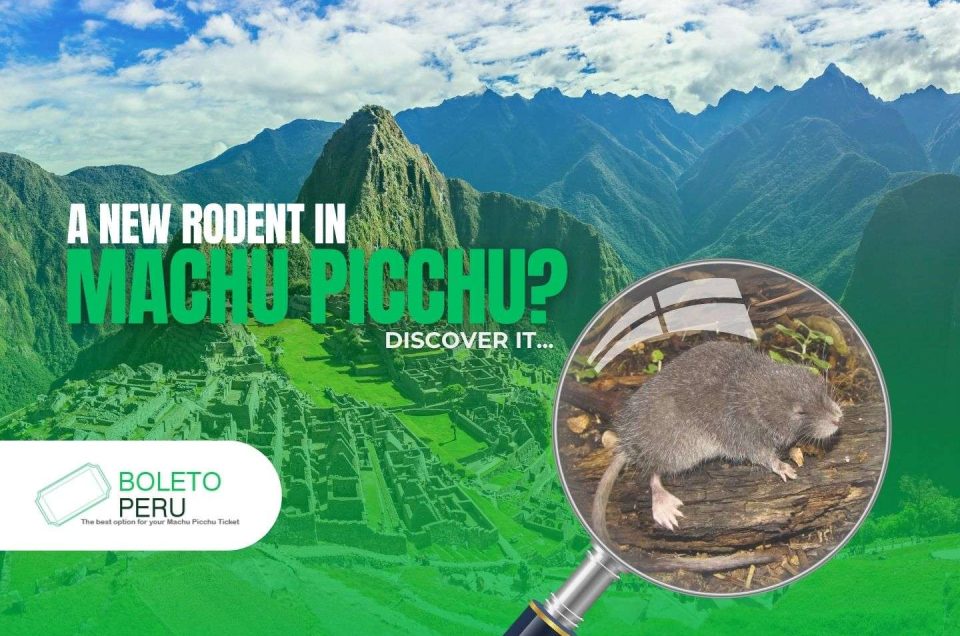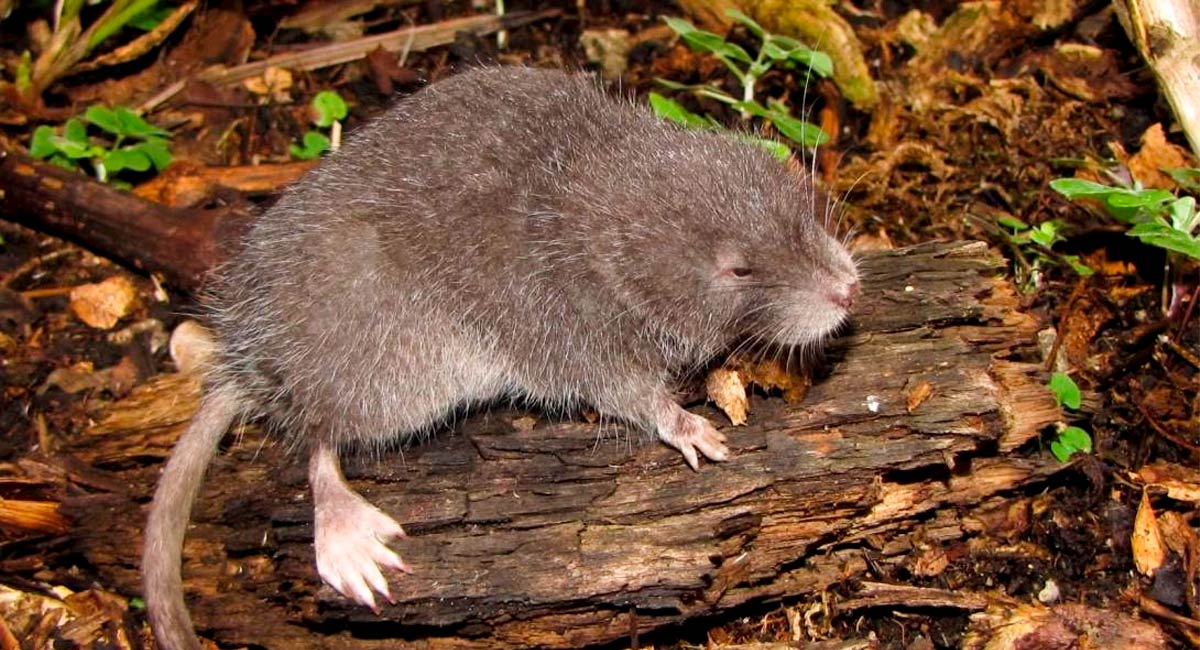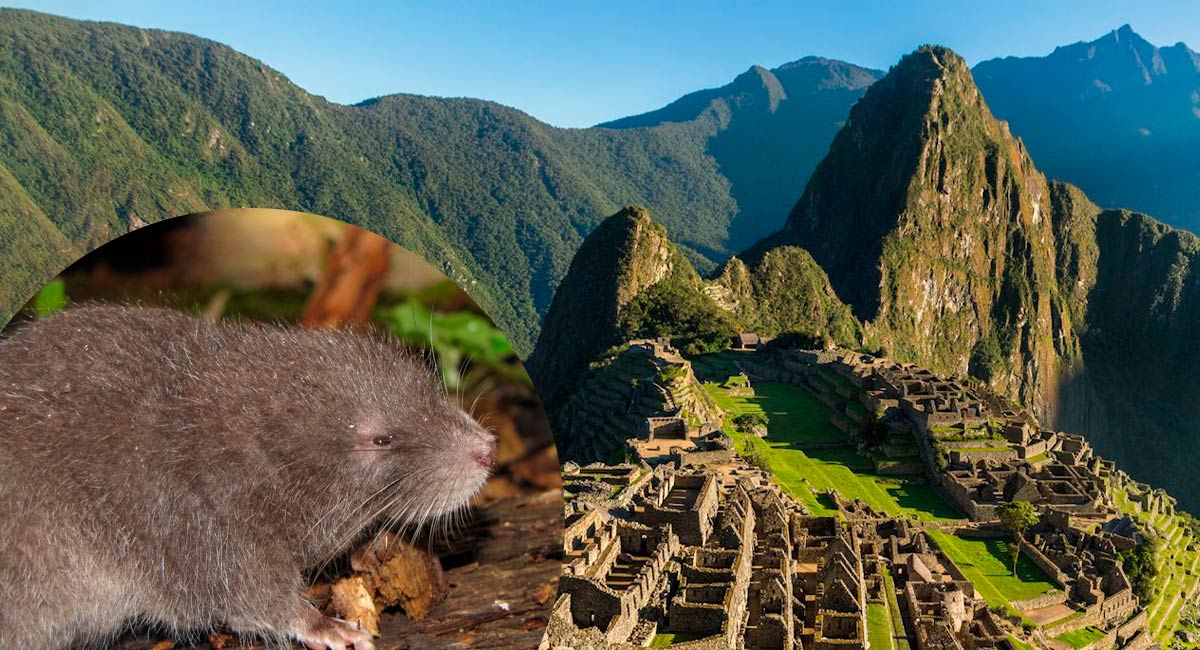A recent study published by the prestigious scientific journal Diversity has revealed a discovery of great relevance for biology and conservation: the identification of a new genus and species of semi-aquatic rodent within the Historic Sanctuary of Machu Picchu. This small mammal has been named Incanomys mayopuma and was found in the Wiñaywayna area, a sector characterized by its high humidity, dense vegetation, and mountain streams.
The habitat of this species is located at more than 2,800 meters above sea level, in an environment where montane forests and water courses converge. This combination of conditions favors the development of specialized fauna. Incanomys mayopuma has gray fur, hind legs modified for swimming, and vestigial ears that remain hidden in its fur, which suggests an evolutionary adaptation to the aquatic environment.
The discovery was made by a team of researchers from the Catholic University of Santa María and the National University of San Agustín of Arequipa, made up of specialists such as Horacio Zeballos, Alexander Pari, and César Medina, among others. The study, based on morphological and genetic analyses, concludes that it is a distinct evolutionary lineage, not previously recorded anywhere else in the world.
This discovery not only expands the catalog of endemic species in the country but also strengthens the scientific value of the Machu Picchu Sanctuary, demonstrating that its ecosystems still harbor organisms unknown to science. The research highlights the importance of continuing to explore areas of high biodiversity with a scientific and conservationist approach.
Unique characteristics of Incanomys mayopuma
This rodent represents a novelty for science due to its set of morphological and ecological traits, which distinguish it from other known species in the Andean region.
- Habitat: It lives in humid montane forests and Andean streams, a demanding environment that requires specific skills to move between water currents and dense vegetation.
- Recorded altitude: It has been observed at about 2,800 meters above sea level, an area that presents variable climatic conditions and lower oxygen concentration, which requires a special physiological adaptation.
- Fur: It has dense, protective gray fur, ideal for staying dry and regulating its body temperature in cold and humid environments. The ears are vestigial and almost hidden in the fur, possibly as an adaptation to reduce heat loss and facilitate movement in water.
- Physical adaptations: Its hind legs show characteristics adapted to a semi-aquatic lifestyle. It is presumed that these limbs allow it to swim efficiently and move easily in areas with currents. This ability gives it an advantage for hunting, avoiding predators, and seeking shelter.
- Diet: Its diet is carnivorous. This suggests that it feeds on small aquatic or terrestrial invertebrates, which is unusual among Andean rodents.
In addition, the scientific name Incanomys mayopuma reflects both the cultural heritage of the place where it was found and its ecological characteristics. “Incanomys” alludes to the Inca civilization and its link with Machu Picchu, while “mayopuma” combines two Quechua terms: mayu (river) and puma, referring to its riparian environment and its role as a predator. This name underlines the connection between culture, native language, and Andean nature.
Scientific and Ecological Value
The discovery of Incanomys mayopuma represents a significant advance in the study of Andean rodents and expands our understanding of the evolution of species adapted to aquatic habitats in high mountain areas.
This new species, belonging to the Ichthyomyini group, shows biological characteristics that differentiate it from other previously known species, such as its hind legs modified for moving in fast-flowing streams and its vestigial ears covered by fur, key adaptations for surviving in humid and forested high-altitude environments.
The fact that this species was found within the Machu Picchu highlights the role of natural protected areas as essential spaces for scientific research. These places offer suitable conditions for conserving unaltered habitats, where unique species can still be discovered. Furthermore, this type of finding contributes to the knowledge about evolutionary processes in geographical areas with high biological diversity such as the Peruvian Andes.
The identification of a new species and genus also strengthens the importance of collaborative work between researchers, universities, and entities responsible for environmental protection, such as the National Service of Natural Protected Areas by the State (SERNANP), who, through patrols, monitoring, and specialized studies, help expand the inventory of species inhabiting Peruvian territory.
Previous discoveries in Machu Picchu
The Historic Sanctuary of Machu Picchu stands out not only for its archaeological and cultural value, but also for being a key setting for the discovery of unique species. In recent years, scientific research and environmental monitoring actions have allowed the registration of species that were previously considered rare, little known, or even extinct.
- Year 2018: During a routine patrol in the Phuyupatamarka sector, SERNANP park rangers documented the presence of the “bamboo rat” (Dactylomis peruanus), a rodent of the Echimyidae family that had not been reported since 2008. This finding evidenced the persistence of species in hard-to-reach areas and the importance of constant monitoring.
- Year 2020: The “arboreal chinchilla rat” (Cuscomys oblativus), a species long believed extinct, was registered again. This result was possible thanks to the use of camera traps installed between April 2018 and April 2019, in sectors such as Wiñay Wayna, Intipata, and Kantupata, located between 2,650 and 3,430 meters of altitude. The rediscovery of this species was a significant contribution to scientific knowledge about Andean fauna.
These records show that the Machu Picchu continues to be a highly relevant place for the study of Andean biodiversity. Thanks to the research and conservation efforts promoted by the Ministry of Environment and SERNANP, the protection of habitats that house endemic species, many of which remain little known to science, has been strengthened.
Diversity of Rodents in Peru
Peru is home to a remarkable variety of rodent species, thanks to its multiple ecosystems ranging from humid Amazonian forests to Andean peaks. This ecological diversity has favored the evolution of species with unique adaptations, both in behavior and morphology. Many of these rodents play a crucial role in the balance of their respective habitats: they disperse seeds, serve as prey for predators, and maintain the health of ecosystems by influencing plant growth or insect control. Below, some notable representatives:
- Wild guinea pig (Cavia tschudii): Considered the ancestor of the domestic guinea pig, this small rodent lives in high Andean areas. Its domestication dates back to pre-Inca times, and today it is an important part of traditional culture and diet.
- Vizcacha (Lagidium peruanum): A resident of high-altitude rocky environments, this rodent has thick fur and a long, bushy tail that allows it to survive in cold, dry conditions. It is often seen in family groups on rocky outcrops.
- Forest rat (Euryoryzomys nitidus): It inhabits the Peruvian Amazon, especially in transition zones between the forest floor and the undergrowth. It has nocturnal habits and is a key species for understanding the dynamics of jungle rodents.
- Ronco (Proechimys spp.): It is recognized for emitting high-pitched sounds when it feels threatened. It lives mainly in low jungle areas, where its activity helps aerate the soil and distribute seeds.
- Capybara (Hydrochoerus hydrochaeris): The largest known rodent in the world. It inhabits swampy areas and riverbanks. It feeds on grasses and aquatic plants and is usually found in groups. Its presence indicates good health in aquatic ecosystems.
- Pacarana (Dinomys branickii): Rare and infrequent, this large rodent inhabits jungles in the north and center of the country. Its slow movement and size differentiate it from other Amazonian rodents.
- Chinchilla (Chinchilla chinchilla): Currently critically endangered, this species inhabited arid and cold areas of the Andes. Its valuable fur has been the cause of its indiscriminate hunting, and today its sighting in the wild is extremely rare.
- Agouti (Dasyprocta variegata): It is found in Amazonian forests, where it acts as a seed disperser for important trees such as the shihuahuaco. Its activity helps forest regeneration and the maintenance of tree species of great ecological value.
The variety of rodents in Peru reflects the richness and complexity of its natural landscapes. Each species fulfills specific ecological functions, being a key piece in the structure of the ecosystems where it lives. Knowing them allows a better understanding of the natural processes that sustain the country’s biodiversity.



